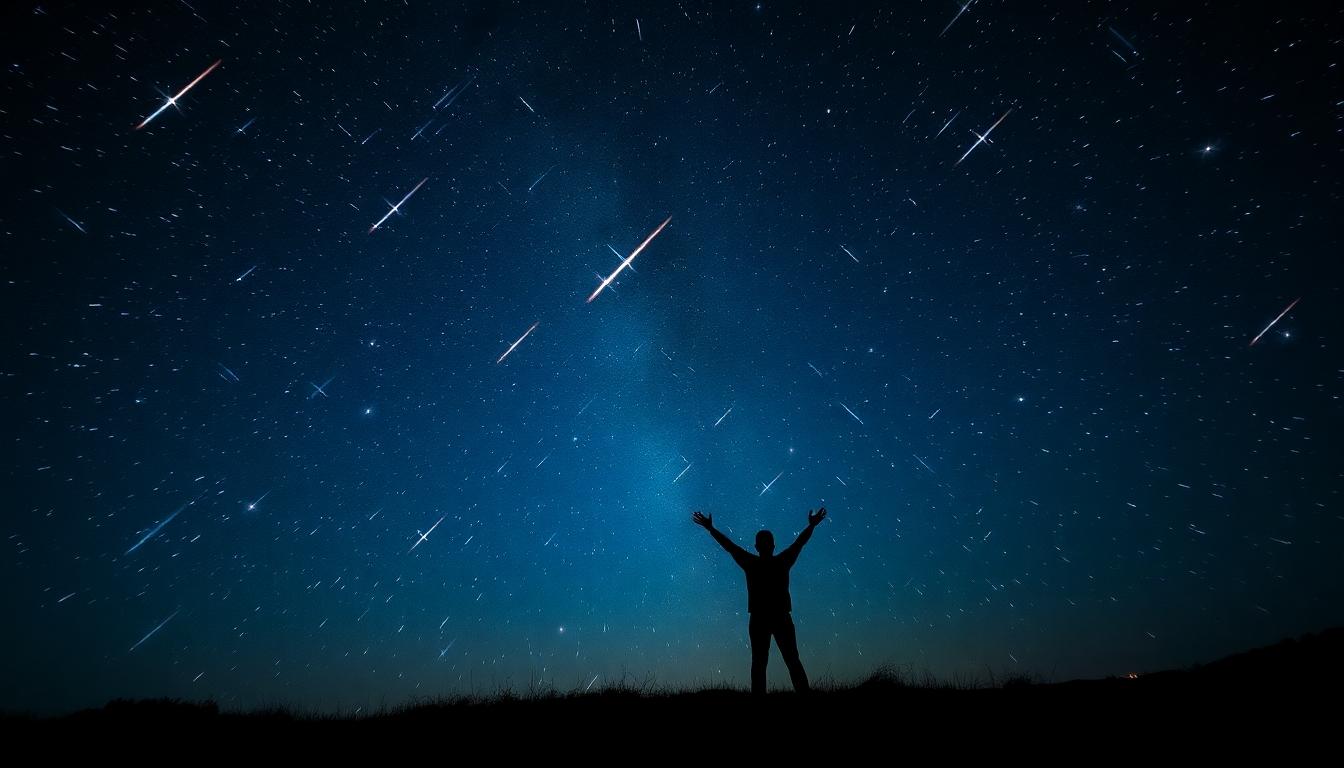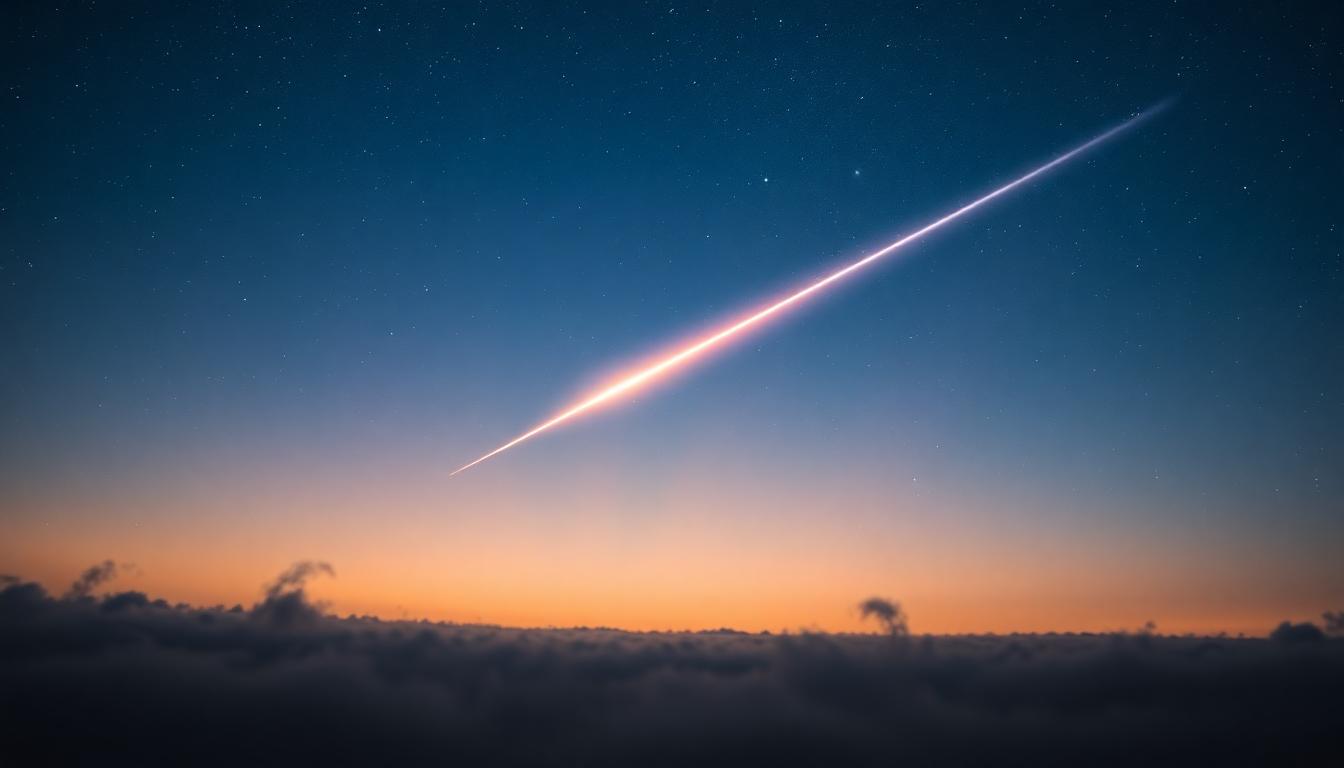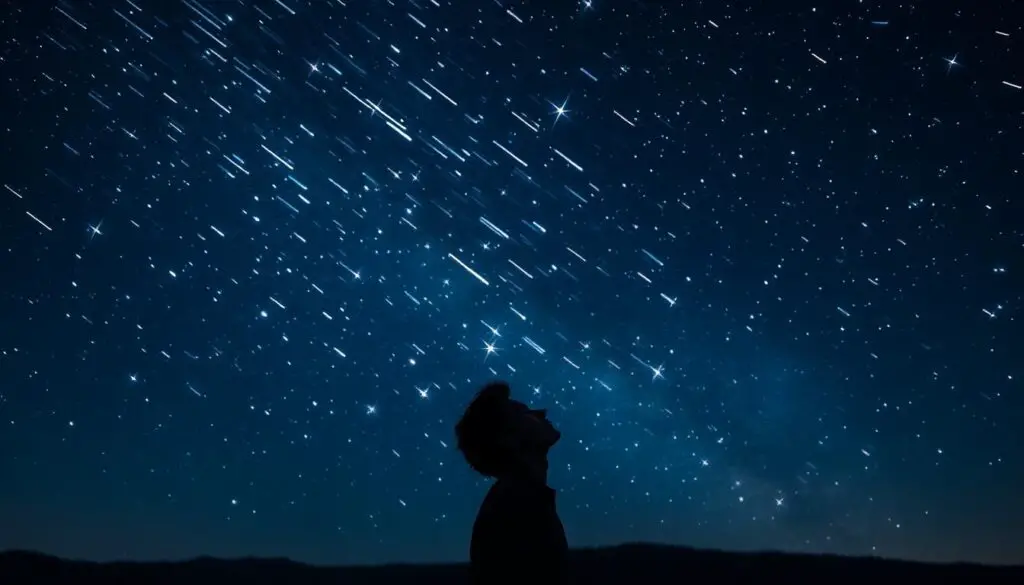Have you ever gazed up at the night sky and witnessed a shooting star streak across the darkness? These fleeting celestial events have captivated humanity for millennia, often believed to carry profound spiritual significance beyond their astronomical explanation.
We’ll explore the rich tapestry of meanings attributed to shooting stars across various cultures and spiritual traditions. From ancient civilizations that viewed them as divine messages to modern interpretations connecting them with wish-making, transformation, and spiritual awakening, shooting stars represent much more than burning space debris entering our atmosphere. Join us as we uncover the deeper spiritual symbolism behind these magical moments that connect us to the cosmos.
Related Posts:
- Black Star Spiritual Meaning: Unlocking Mystery, Transformation & Personal Growth
- Shooting Star Spiritual Meaning: Cosmic Messages & Wish-Making Magic Revealed
- 7 Pointed Star Spiritual Meaning: Unlock the Secrets of This Powerful Symbol
- Unlock the 4 Pointed Star Spiritual Meaning: Discover Balance and Protection
- 10 Pointed Star Spiritual Meaning Revealed: Unlock Ancient Secrets for Your Journey
- Discover the Crescent Moon Star Spiritual Meaning: Symbolism Across Cultures
- Unlock the 3 Pointed Star: Deep Dive into Its Spiritual Meaning & Symbolism
- Decoding the 9-Pointed Star: Its Spiritual Significance and Impact Across Cultures
The Phenomenon of Shooting Stars
Shooting stars aren’t actually stars at all but meteors—small pieces of rock or dust that enter Earth’s atmosphere at incredible speeds. These particles heat up due to friction with air molecules, creating the luminous streaks we observe across the night sky. Most meteors completely burn up before reaching the ground, typically at altitudes between 50-75 miles above Earth’s surface.
The breathtaking light display occurs when these speeding space rocks, often no larger than a grain of sand, reach temperatures of over 3,000 degrees Fahrenheit during their atmospheric journey. Scientists classify these celestial events as “meteors” while they’re streaking through the sky, “meteoroids” when they’re still in space, and “meteorites” if they survive the journey to reach Earth’s surface.
Meteor showers represent periods of increased meteor activity, happening when Earth passes through debris trails left by comets. Notable annual meteor showers include the Perseids (August), Leonids (November), and Geminids (December), each capable of producing up to 120 meteors per hour at their peak. These spectacular cosmic displays have captivated humans for millennia, serving as the foundation for various spiritual and cultural interpretations.
Shooting stars move at astonishing velocities, typically between 25,000 to 160,000 miles per hour. Their appearance in the night sky lasts for just a fraction of a second to several seconds, making each sighting a rare and fleeting moment. The transient nature of shooting stars contributes significantly to their symbolic importance in spiritual traditions, representing transformation, transition, and the ephemeral quality of existence.
Cultural Significance of Shooting Stars Throughout History

Shooting stars have captivated human imagination across civilizations, serving as powerful symbols in cultural narratives worldwide. Their fleeting brilliance has inspired interpretations that connect celestial phenomena to spiritual realms and divine communication.
Ancient Mythologies and Shooting Stars
Ancient Eastern civilizations viewed meteors as practical cosmic guidance, interpreting their appearance as favorable omens for agriculture and commerce. These celestial events functioned as encouragement signs, essentially telling observers to proceed with their planned endeavors. Pre-modern societies established deep connections between shooting stars and spiritual journeys, often seeing them as souls transitioning between different realms of existence. Many global mythologies portrayed these streaking lights as celestial messengers carrying important communications from ancestors or deities. The symbolic significance of shooting stars transcended mere astronomical phenomena, embedding them within cultural frameworks that explained human connection to the cosmos and afterlife.
Shooting Stars in Religious Traditions
Christian interpretations frame shooting stars as divine messages or moments of spiritual clarity that guide believers in times of uncertainty. These brief celestial displays serve as bridges connecting earthly existence to higher powers across many faith traditions. Their transient nature symbolizes life’s impermanence, creating perfect metaphors for transformation and renewal in religious teachings. Shooting stars represent fleeting opportunities for wishes or prayers in many spiritual practices, offering brief windows when the barrier between physical and spiritual realms thins. The universal themes of change and cosmic connection appear consistently in religious interpretations of shooting stars, demonstrating how these astronomical events transcend cultural boundaries while maintaining spiritual significance.
Spiritual Meanings of Seeing a Shooting Star

Shooting stars captivate our imagination and hold profound spiritual significance across cultures. Their fleeting brilliance carries powerful symbolic meanings that have inspired humanity for centuries.
Divine Messages and Guidance
Shooting stars function as celestial signals in spiritual traditions worldwide. Multiple cultures interpret these luminous streaks as communications from higher powers or divine entities attempting to connect with humanity. Ancient Greek philosopher Ptolemy established the foundation for our “wish upon a star” tradition, believing that shooting stars appeared when deities opened the heavens to observe Earth. Christians often perceive shooting stars as moments of spiritual clarity or divine messages, providing comfort during periods of faith uncertainty. The brief, unexpected nature of shooting stars serves as a cosmic prompt for self-reflection, encouraging us to consider our life direction or seek guidance from universal forces.
Transformation and New Beginnings
Shooting stars universally symbolize transformation and renewal in spiritual contexts. Their ephemeral presence mirrors life’s impermanence, inviting us to embrace transitions rather than resist them. Several cultural traditions connect these celestial events with new beginnings, marking the commencement of personal or spiritual journeys. Other interpretations view shooting stars as symbolic closures, clearing energetic pathways for fresh opportunities and experiences. The appearance of a shooting star often signals upcoming positive changes, reminding us to prepare for transformation in our lives. This cross-cultural symbolism includes associations with good fortune, soul journeys, and alignment with destiny, positioning shooting stars as cosmic connectors bridging our earthly existence with spiritual realms.
Making Wishes Upon Shooting Stars

The tradition of making wishes upon shooting stars connects us to ancient practices that span cultures worldwide. This romantic gesture creates intimate moments between individuals while opening channels to universal energies that may help manifest our deepest desires.
The Power of Intention and Manifestation
Shooting stars carry positive significance in spiritual traditions, often associated with good fortune that strengthens our intentions. Their sudden appearance creates a perfect opportunity to focus our thoughts and connect with celestial forces. Many spiritual practitioners believe these fleeting celestial events create energetic openings where our wishes can more easily enter the universe’s manifestation field. The brief moment we witness a shooting star provides a natural pause for mindfulness—a split second where our attention fully aligns with cosmic energies, potentially amplifying our ability to manifest desires.
How to Properly Make a Wish on a Shooting Star
Making wishes on shooting stars follows exact traditional practices that maximize their potential effectiveness. First, remain aware and present during stargazing sessions to notice shooting stars immediately as they appear. Next, quickly formulate your wish with clear, exact intent rather than vague desires. Express your wish swiftly before the meteor disappears from view—tradition holds that wishes made after the star fades lose their power. Finally, cultivate genuine belief in your intentions, trusting that your wish has been received by the universe. This practice taps into the deeply rooted cultural and spiritual significance that shooting stars have maintained throughout human history.
Personal Spiritual Growth and Shooting Stars

Shooting stars serve as powerful catalysts for personal transformation and spiritual awakening. Their fleeting brilliance across the night sky symbolizes momentary yet profound opportunities for inner change and self-reflection. These celestial events have been recognized across cultures as natural invitations to embrace life’s cyclical patterns and possibilities for renewal.
Using Celestial Events for Meditation
Meditation during or after witnessing a shooting star enhances spiritual awareness and deepens personal growth practices. Many practitioners focus on the star’s transient nature as a perfect metaphor for impermanence, using this awareness to cultivate greater mindfulness and present-moment consciousness. This meditative approach involves sitting quietly after seeing a meteor, allowing its image to remain in your mind’s eye while breathing deeply and releasing attachments to outcomes or situations that no longer serve you.
Visualization techniques often accompany meteor meditation, with observers imagining their intentions traveling alongside the shooting star into the cosmos. Some spiritual traditions suggest that these fleeting celestial moments create energetic openings where affirmations and prayers can be amplified. The practice typically includes focusing on the shooting star’s path, acknowledging its brief but magnificent journey, and connecting this symbolism to one’s own spiritual path.
Connecting with the Universe Through Shooting Stars
Across diverse cultural traditions, shooting stars function as symbolic bridges between earthly existence and celestial realms. Native spiritual practices interpret these luminous streaks as messages from ancestors or divine forces, emphasizing our fundamental interconnectedness with all creation. Christianity sometimes views meteors as divine guidance or answers to faithful prayers, offering reassurance during challenging times.
Experiencing a shooting star often triggers profound feelings of awe and cosmic unity in observers. This sensation—frequently described as a momentary dissolution of boundaries between self and universe—creates perfect conditions for spiritual insights and revelations. Spiritual seekers frequently report that meteor sightings coincide with important decisions or life transitions, appearing at precisely the moment guidance is needed.
Many meditation teachers recommend using shooting star sightings as opportunities to contemplate humanity’s place within the vast cosmos. The perspective shift from witnessing these celestial travelers helps dissolve everyday concerns and reconnect with larger spiritual questions about purpose and meaning. Their unexpected appearances remind us that while individual human lives may seem small within the cosmic scale, each person remains an integral part of the universe’s unfolding story.
Modern Interpretations of Shooting Star Symbolism

Shooting stars transcend their scientific reality as meteors burning in Earth’s atmosphere to embrace rich spiritual significance across global cultures. Throughout the industry, these celestial phenomena universally symbolize good luck, positive change, and fleeting opportunity, prompting countless individuals to pause, reflect, and make wishes upon their sighting.
The manifestation potential of shooting stars stands as a powerful modern interpretation, with many spiritual practitioners viewing them as cosmic prompts to focus intentions. Traditional practices encourage making wishes during these rare sightings, believing the universe opens momentarily to receive our deepest desires and aspirations.
Divine communication remains a central theme in contemporary understanding of shooting stars, linking these celestial events to guidance or reassurance from higher powers. Biblical interpretations associate shooting stars with answered prayers or moments of spiritual awakening, reinforcing their role as celestial messengers in many faith traditions.
Transitions symbolism permeates modern interpretations, with shooting stars representing pivotal moments of change. These fleeting lights mark new beginnings, important endings, or perfect alignment with one’s spiritual journey, serving as cosmic signposts during life’s groundbreaking phases.
Love and connection emerge as meaningful associations in current spiritual perspectives, with shooting stars often linked to romantic opportunities or gentle reminders to cherish existing relationships. Many couples consider witnessing a shooting star together as a powerful affirmation of their bond.
Cultural interpretations continue to evolve while maintaining core spiritual elements:
- Comfort bearers during difficult times, shooting stars offer messages of peace and hope, paralleling biblical narratives where natural phenomena convey divine presence
- Soul journey markers appear in traditions that perceive shooting stars as traveling souls or celestial beings observing humanity from afar
- Universal alignment symbols encourage trust in life’s natural flow and validation of personal growth paths
Modern spirituality often merges these diverse themes, positioning shooting stars as universal markers of cosmic alignment. Their unexpected appearance validates our spiritual journey, encourages trust in life’s unfolding process, and confirms we’re exactly where we need to be in our personal evolution.
Conclusion
Shooting stars remain among the most enchanting celestial phenomena we can witness. Their fleeting beauty carries profound spiritual significance that transcends cultural boundaries and time itself. As we gaze upward at these cosmic messengers we connect with something greater than ourselves.
Whether you view them as divine communications reminders of life’s impermanence or powerful catalysts for manifestation shooting stars invite us to pause and reflect on our place in the universe. Their ephemeral brilliance encourages us to embrace change seize opportunities and trust in our journey.
Next time you glimpse that luminous streak across the night sky remember you’re participating in a timeless human experience that bridges the physical and spiritual realms. The magic of shooting stars lies not just in their scientific wonder but in how they ignite our souls with possibility.
Frequently Asked Questions
What are shooting stars?
Shooting stars are actually meteors—small pieces of rock or dust that enter Earth’s atmosphere at high speeds. As they travel through the atmosphere, friction causes them to heat up and create the luminous streaks we see in the night sky. Most meteors burn up completely before reaching Earth’s surface, typically at altitudes between 50-75 miles.
How fast do shooting stars travel?
Shooting stars move at incredible speeds ranging from 25,000 to 160,000 miles per hour. This extraordinary velocity contributes to the friction with Earth’s atmosphere, causing them to heat up and emit the bright light we observe. Their fleeting nature—lasting only seconds—enhances their symbolic importance in various spiritual traditions.
What is the difference between a meteor, meteoroid, and meteorite?
A meteoroid is the object while it’s still in space. When it enters Earth’s atmosphere and creates a visible streak of light, it becomes a meteor (shooting star). If the object survives its journey through the atmosphere and lands on Earth’s surface, it’s then called a meteorite. Most meteors burn up completely before becoming meteorites.
What causes meteor showers?
Meteor showers occur when Earth passes through debris trails left behind by comets orbiting the sun. During these events, multiple meteors appear to radiate from the same point in the sky. Notable annual meteor showers include the Perseids (August), Leonids (November), and Geminids (December), each named after the constellation from which they appear to originate.
Why do people make wishes on shooting stars?
The tradition of wishing upon shooting stars spans cultures worldwide and dates back centuries. Many believe that the sudden, rare appearance of a shooting star creates an energetic opening for wishes to enter the universe’s manifestation field. The fleeting nature of shooting stars adds urgency and power to the wish-making process, encouraging sincere intentions.
What spiritual significance do shooting stars have?
Across cultures, shooting stars are viewed as celestial signals connecting humans with higher powers. They’re often interpreted as divine messages offering guidance and clarity. Ancient Eastern societies considered them favorable omens, while many mythologies viewed them as messengers from deities or ancestors. They universally symbolize transformation, transition, and the ephemeral quality of existence.
How should I make a wish on a shooting star?
To effectively wish upon a shooting star, be present and mindful when observing the night sky. When you spot a shooting star, quickly formulate a clear, specific intention—avoid vague wishes. Speak or think your wish immediately while the meteor is visible. Cultivate genuine belief in your wish’s potential and maintain gratitude regardless of the outcome.
What do shooting stars symbolize in modern spiritual practices?
In modern spirituality, shooting stars represent good luck, positive change, and opportunity. They’re viewed as cosmic prompts for intention-setting and divine communication. Many spiritual practitioners interpret them as signs of transition, new beginnings, or romantic connections. They’re also seen as comfort bearers during difficult times and cosmic validators of personal growth journeys.
How common are shooting stars?
Shooting stars are surprisingly common, with approximately 25 million meteors entering Earth’s atmosphere daily. However, most are too small to be visible or occur during daylight hours. Under ideal dark-sky conditions away from light pollution, an observer might see 5-10 meteors per hour on an average night, with rates increasing dramatically during meteor showers.
Can shooting stars hit the Earth?
While most meteors burn up completely in the atmosphere, some larger objects do reach Earth’s surface as meteorites. However, the chance of being struck by a meteorite is incredibly small—estimated at about 1 in 1.6 million during your lifetime. The vast majority of meteorites land in uninhabited areas, particularly oceans which cover 70% of Earth’s surface.







